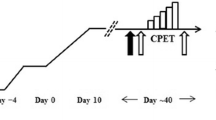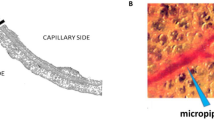Abstract
The diffusing capacity of the lung for carbon monoxide (DLCO) decreases to below the pre-exercise value in the hours following a bout of intense exercise. Two mechanisms have been proposed: (1) development of pulmonary oedema and (2) redistribution of central blood volume to peripheral muscles causing a reduction in pulmonary capillary blood volume (Vc). In the present study DLCO, Vc and the membrane diffusing capacity (Dm) were measured in nine healthy females using a rebreathing method, in contrast to the single breath technique employed in previous studies. DLCO, Vc and Dm were measured before and at 1, 2, 3, 16 and 24 h following maximal treadmill exercise. Compared with pre-exercise values, DLCO was depressed by up to 8.9 (3.0)% (P<0.05) for the first 3 h following exercise, but had returned to pre-exercise values by 16 h post-exercise. Vc fell by 21.2 (4.1)% (P<0.05) at 3 h post-exercise, but at the same time Dm increased by 14.7 (9.1)%. It was concluded that: (1) the increase in Dm made it unlikely that the fall in DLCO was due to interstitial oedema and injury to the blood gas barrier; (2) on the other hand, the reduction in DLCO following exercise was consistent with a redistribution of blood away from the lungs; and (3) the trend for Dm and Vc to reciprocate one another indicates a situation in which a fall in Vc nevertheless promotes gas transfer at the respiratory membrane. It is suggested that this effect is brought about by the reorientation of red blood cells within the pulmonary capillaries following exercise.


Similar content being viewed by others
References
Bates DV, Varvis CJ, Donevan, RE, Christie, RV (1960) Variations in the pulmonary capillary blood volume and membrane diffusion component in health and disease. J Clin Invest 39:1401–1408
Borg GA (1974) Perceived exertion. Exerc Sport Sci Rev 2:131–153
Clark EH, Jones HA, Hughes, JMB (1978) Bedside rebreathing technique for measuring carbon-monoxide uptake by the lung. Lancet 1:791–793
Cotes JE (1993) Lung function, assessment and application in medicine, 5th edn. Blackwell Scientific, Oxford
Gotshall RW, Davrath LR (1999) Cardiovascular effects of the breathhold used in determining pulmonary diffusing capacity. Aviat Space Environ Med 70:471–474
Hammond MD, Gale GE, Kapitan KS, Ries A, Wagner PD (1986) Pulmonary gas exchange in humans during exercise at sea level. J Appl Physiol 60:1590–1598
Hanel B, Clifford PS, Secher NH (1994) Restricted post-exercise pulmonary diffusion capacity does not impair maximal transport for O2. J Appl Physiol 77:2408–2412
Hanel B, Gustafsson F, Larsen HH, Secher NH (1993) Influence of exercise intensity and duration on post-exercise pulmonary diffusion capacity. Int J Sports Med 14:S11-S14
Hanel B, Law I, Mortensen J (2003) Maximal rowing has an acute effect on the blood-gas barrier in elite athletes. J Appl Physiol 95:1076–1082
Hanel B, Teunissen I, Rabol A, Warberg J, Secher NH (1997) Restricted postexercise pulmonary diffusion capacity and central blood volume depletion. J Appl Physiol 83:11–17
Hopkins SR, Belzberg AS, Wiggs BR, McKenzie DC (1996) Pulmonary transit time and diffusion limitation during heavy exercise in athletes. Respir Physiol 103:67–73.
Hsia CC, Chuong CJ, Johnson RL (1995) Critique of conceptual basis of diffusing capacity estimates: a finite element analysis. J Appl Physiol 79:1039–1047
Krogh M (1914) The diffusion of gases through the lungs of man. J Physiol (Lond) 49:271–300
Laub M, Hvid-Jacobsen K, Hovid P, Kanstrup I, Christensen NJ, Levine S (1993) Spleen emptying and venous hematocrit in humans during exercise. J Appl Physiol 74:1024–1026
Manier G, Moinard J, Stoïcheff H (1993) Pulmonary diffusing capacity after maximal exercise. J Appl Physiol 75:2580–2585
Manier G, Moinard J, Téchoueyres P, Varene N, Guenard H (1991) Pulmonary diffusion limitation after prolonged strenuous exercise. Respir Physiol 83:143–154
McKenzie DC, Lama IL, Potts JE, Sheel AW, Coutts KD (1999) The effect of repeat exercise on pulmonary diffusing capacity and EIH in trained athletes. Med Sci Sports Exerc 31:99–104
Miles DS, Doerr CE, Schoenfeld SA, Sinks DE, Gotshall RW (1983) Changes in pulmonary diffusing capacity and closing volume after running a marathon. Respir Physiol 52:349–359
Nabors LK, Baumgartner WA, Janke SJ, Rose JR, Wagner WW, Capen RL (2003) Red blood cell orientation in pulmonary capillaries and its effect on gas diffusion. J Appl Physiol 94:1634–1640
Rasmussen BS, Hanel B, Jensen K, Serup B, Secher NH (1986) Decrease in pulmonary diffusion capacity after maximal exercise. J Sports Sci 4:185–188
Rasmussen J, Hanel B, Saunamaki K, Secher NH (1992) Recovery of pulmonary diffusion capacity after maximal exercise. J Sports Sci 10:525–531
Roughton FJW, Forster RE (1957) Relative importance of diffusion and chemical reaction rates in determining rate of exchange of gases in the human lung, with special reference to true diffusing capacity of pulmonary membrane and volume of blood in the lung capillaries. J Appl Physiol 11:290–302
Sheel AW, Coutts KD, Potts JE, McKenzie DC (1998) The time course of pulmonary diffusing capacity for carbon monoxide following short duration high intensity exercise. Respir Physiol 111:271–281
Stewart IB, Potts JE, McKenzie DC, Coutts KD (2000) Effect of body position on measurements of diffusion capacity after exercise. Br J Sports Med 34:440–444
Acknowledgements
We thank the volunteers for participating in this study. This study was supported by a grant from the Royal Hobart Hospital Research Foundation, Tasmania.
Author information
Authors and Affiliations
Corresponding author
Rights and permissions
About this article
Cite this article
Johns, D.P., Berry, D., Maskrey, M. et al. Decreased lung capillary blood volume post-exercise is compensated by increased membrane diffusing capacity. Eur J Appl Physiol 93, 96–101 (2004). https://doi.org/10.1007/s00421-004-1170-x
Accepted:
Published:
Issue Date:
DOI: https://doi.org/10.1007/s00421-004-1170-x




